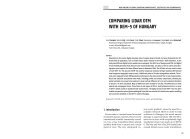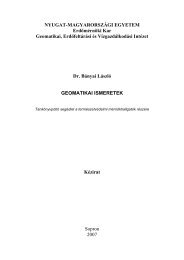Remote sensing methods in soil erosion assessment in the Mátra ...
Remote sensing methods in soil erosion assessment in the Mátra ...
Remote sensing methods in soil erosion assessment in the Mátra ...
Create successful ePaper yourself
Turn your PDF publications into a flip-book with our unique Google optimized e-Paper software.
ACTA Geographica Szegediensis Tomus XXXI. 1993. pp. 89-98.<br />
<strong>Remote</strong> <strong>sens<strong>in</strong>g</strong> <strong>methods</strong> <strong>in</strong> <strong>soil</strong> <strong>erosion</strong> <strong>assessment</strong><br />
<strong>in</strong> <strong>the</strong> Mátra Mounta<strong>in</strong>s, Hungary<br />
Dr. Gábor Mezõsi - Dr. Lás7ló Mucsi<br />
Abstract<br />
In <strong>the</strong> test site, which is situated <strong>in</strong> <strong>the</strong> nor<strong>the</strong>rn part of Hungary <strong>in</strong> <strong>the</strong> Mátra Mounta<strong>in</strong>s<br />
<strong>the</strong>re are various lithological and morphological conditions toge<strong>the</strong>r with special land uses.<br />
In <strong>the</strong> test area, <strong>the</strong> importance of relief, plant cover characteristics and <strong>the</strong> physical<br />
properties of <strong>the</strong> <strong>soil</strong> types can be emphasized by exam<strong>in</strong><strong>in</strong>g <strong>the</strong> degree of <strong>soil</strong> <strong>erosion</strong><br />
caused by water. Different tieId measurements based on <strong>soil</strong> mapp<strong>in</strong>g were performed to<br />
assess <strong>the</strong> <strong>erosion</strong> <strong>in</strong>tensity of <strong>the</strong> area. Landsat digital data were used to calculate <strong>the</strong> C<br />
and K factors of <strong>the</strong> Wischmeier-Smith formula. These results were compared with tieId<br />
measurement data. The factors of USLE were stored and processed us<strong>in</strong>g a GIS. The tieId<br />
measurement results and <strong>the</strong> values of <strong>soil</strong> <strong>erosion</strong> estimated by <strong>the</strong> Wischmeier-Smith<br />
formula were compared. An estimate of <strong>the</strong> <strong>in</strong>tensity of <strong>soil</strong> <strong>erosion</strong> by dist<strong>in</strong>ctive<br />
composition of Landsat TM images was calculated. This was also compared with <strong>the</strong> USLE<br />
values.<br />
The results show that <strong>the</strong> punctiform measured data can be extracted regionally but that<br />
remote <strong>sens<strong>in</strong>g</strong> <strong>methods</strong> are not enough for an estimation of <strong>soil</strong> <strong>erosion</strong> and must be used<br />
<strong>in</strong> conjunction with tieId measurements. Surf ace areas which have to be protected aga<strong>in</strong>st<br />
<strong>soil</strong> <strong>erosion</strong> were identitied toge<strong>the</strong>r with potential sites which may be destroyed .by this<br />
process <strong>in</strong> <strong>the</strong> future.<br />
Introduction<br />
About 30 % of <strong>the</strong> cultivated area of Hungary is aft"ected by <strong>soil</strong> <strong>erosion</strong>. The <strong>soil</strong><br />
<strong>erosion</strong> lessens <strong>soil</strong> capability and upsets <strong>the</strong> dynamic ecological equilibrium of <strong>the</strong> <strong>soil</strong><br />
system. Because of <strong>the</strong> changes <strong>in</strong> land ownership as a result of privatization, <strong>the</strong>re has<br />
been a significant transformation <strong>in</strong> land use, agricultural technology and <strong>the</strong> area of farms.<br />
The big cooperatives and governmental <strong>soil</strong> conservation services were defuncted and<br />
consequently, new owners ace short of <strong>in</strong>formation concern<strong>in</strong>g <strong>the</strong> <strong>soil</strong> <strong>erosion</strong> risk.<br />
89
,/<br />
,.° --<br />
,...0 /",<br />
(l -<br />
ro-<br />
Eger oN°-J<br />
(<br />
J-- ,<br />
\.) Debrcccn ...<br />
"> BudQpe~t o j<br />
tO<br />
i<br />
\ (<br />
i<br />
o-°<br />
/<br />
'-1- .<br />
,;'<br />
~ '<br />
"<br />
'\<br />
szeg<br />
'-- pecs ..-'<br />
'\. o ,J<br />
-',<br />
°-. ../<br />
Figure 1 The situation of <strong>the</strong> catchment area <strong>in</strong> Hungary<br />
90
The basic ecological conditions are not modified by <strong>the</strong> changes <strong>in</strong> ownership and th<br />
erefore a catchment area (Fig. 1) was chosen as <strong>the</strong> test site unit. Consider<strong>in</strong>g this fact,<br />
<strong>the</strong> USLE formula was applied to <strong>the</strong> catchment area. The ma<strong>in</strong> aim of <strong>the</strong> study was to<br />
locate those areas which are endangered by <strong>soil</strong> <strong>erosion</strong> <strong>in</strong>dependently of <strong>the</strong> borders of<br />
land parcels and to f<strong>in</strong>d areas <strong>in</strong> which <strong>the</strong> dynamic equilibrium is upset.<br />
METHODS<br />
In <strong>the</strong> <strong>in</strong>vestigation <strong>the</strong> unitied <strong>soil</strong> loss equation (USLE - Wischmeier, W. H. -Smith,<br />
D.D. 1978) was used. The USLE is an <strong>erosion</strong> model, which assesses <strong>the</strong> <strong>soil</strong>loss for a<br />
given site as <strong>the</strong> product of six major factors, whose most likely values at a particul ar<br />
location can be expressed numericaIly. The <strong>soil</strong>loss per unit area is (A):<br />
A=R*K*Ls*C*P<br />
where R - <strong>the</strong> ra<strong>in</strong>fall and runoff factor (most important part is <strong>the</strong> ra<strong>in</strong>fall erosioff <strong>in</strong>dex),<br />
K - <strong>the</strong> <strong>soil</strong> erodibility factor, Ls - slope length and steepness factor, C - surf ace cover<strong>in</strong>g<br />
and management factor, P - support practice factor. The two complicated factors K and C<br />
were controlled with <strong>the</strong> help of remote <strong>sens<strong>in</strong>g</strong> <strong>methods</strong>. The K factor was simultaneously<br />
experimentally measured <strong>in</strong> <strong>the</strong> tieId us<strong>in</strong>g a tield-plot ra<strong>in</strong>fall simulator. The K factor<br />
depends ma<strong>in</strong>lyon <strong>soil</strong> type and texture, which allows <strong>the</strong> use of remote <strong>sens<strong>in</strong>g</strong> <strong>methods</strong>.<br />
There are a lot of formulae to express <strong>the</strong> NDVI or <strong>the</strong> biomass value of a surface by<br />
measur<strong>in</strong>g <strong>the</strong> vegetation cover characteristics and from <strong>the</strong>se, <strong>the</strong> regional differences of<br />
<strong>the</strong> C factor can be assessed. The C value was also calculated from <strong>the</strong> suggested tables <strong>in</strong><br />
Wischmeier and Smith (1978). AlI bands of <strong>the</strong> Landsat TM image recorded on 7 July,<br />
1987 were used because <strong>the</strong> ra<strong>in</strong>fall <strong>in</strong>tensity (EI) and <strong>the</strong> predicted <strong>soil</strong> <strong>erosion</strong> give <strong>the</strong><br />
highest rate <strong>in</strong> this early summer period. The LS values were measured us<strong>in</strong>g tieId<br />
<strong>methods</strong>. The maps were digitized <strong>in</strong> AutoCAD and <strong>the</strong> results were transferred to IDRlSI<br />
v. 4.0 (Eastman, J.R. 1992). In IDRISI <strong>the</strong> vector database was con verted <strong>in</strong>to a raster<br />
database, and stored <strong>in</strong> GIS. The rasterized database was <strong>the</strong>n used to compare tieid<br />
measurement data with <strong>the</strong> remotely sensed data. The best composite of different TM bands<br />
which substitute <strong>the</strong> slow process of <strong>the</strong> experimental tieid measurement data can <strong>the</strong>n be<br />
dist<strong>in</strong>guished .<br />
RES UL TS<br />
Some factors <strong>in</strong> <strong>the</strong> USLE formula can be easily calculated or, ow<strong>in</strong>g to <strong>the</strong> <strong>in</strong>signiticant<br />
differences, <strong>the</strong> factor value can be constant. For example, <strong>the</strong> P factor is equal to 1 for<br />
<strong>the</strong> entire catchment area because <strong>the</strong>re was no special <strong>soil</strong> conservation management.<br />
O<strong>the</strong>r factors, such as L and S, were measured at <strong>the</strong> test site: <strong>the</strong> value of steepness<br />
of land slope ranges from 10 to 12 %, while <strong>the</strong> length of land slope ranges from 300 to<br />
500 m. The LS vaIues <strong>the</strong>refore, are more than 3 and less than 5. It may also be deduced<br />
that <strong>the</strong> steepness of <strong>the</strong> land slope is greater <strong>in</strong> <strong>the</strong> western part of <strong>the</strong> catchment than on<br />
<strong>the</strong> cultivated eastern part.<br />
91
N<br />
i<br />
')nit ro j<br />
o 1 k~<br />
. .<br />
. . . . I I ri :1 ~;~<br />
.\ L 3 " ". , !I I , 10<br />
Figure 2 Map of <strong>soil</strong> erodibility factor (K) on <strong>the</strong> catchment<br />
1 - 0.11; 2 - 0.18; 3 - 0..25; 4 - 0.26; 5 co 0.28;<br />
6~.29; 7 - 0.3; 8 - 0.32; 9 - 0.35<br />
The <strong>soil</strong> erodibility factor (K) must be evaluated <strong>in</strong>dependently of <strong>the</strong> effects of <strong>the</strong> o<strong>the</strong>r<br />
factors. The K factor <strong>in</strong> <strong>the</strong> USLE is a quantitative value which is experimentally<br />
detern)<strong>in</strong>ed. The calculation of this factor is difficult and requires measurement, but with<br />
<strong>the</strong> help of <strong>the</strong> <strong>soil</strong> erodibility nomograph <strong>the</strong> approached value can be calculated if <strong>the</strong><br />
<strong>soil</strong>' s sand content, <strong>the</strong> amount of organic matter, <strong>the</strong> structure and permeability are known.<br />
A map of K factors for <strong>the</strong> entire catchment area was constructed. In spite of <strong>the</strong> f<strong>in</strong>e<br />
resolution <strong>the</strong>re are no significant differences between <strong>the</strong> K value of <strong>the</strong> patterns, and it<br />
ranges between 0.1 and 0.3 <strong>in</strong> 95 % of <strong>the</strong> area (Fig. 2). In <strong>the</strong> transitional zone between<br />
<strong>the</strong> cultivated area (meadow, grass land, pasture, orchard) and <strong>the</strong> uncultivated area (forest,<br />
deciduous forest, acacia grove, hydrophyte association), small patterns occur and it is here<br />
that greater differences between <strong>the</strong> K values are found.<br />
A TM image or image composition, which can represen<strong>the</strong> same conditions as <strong>the</strong> map<br />
of <strong>the</strong> K factor, was determ<strong>in</strong>ed. However, <strong>the</strong> calculation of <strong>the</strong> K factor is difficult and<br />
it is not <strong>the</strong> game as <strong>soil</strong> <strong>erosion</strong>, <strong>the</strong>refore <strong>the</strong>re is not a s<strong>in</strong>gle image which can take <strong>the</strong><br />
place directly of <strong>the</strong> orig<strong>in</strong>al method. on <strong>the</strong> 742 (RGB) TM composite <strong>the</strong> important<br />
92
a.. /1/<br />
r<br />
A<br />
3<br />
A-<br />
Figure 3 7,4,2 (RGB) Landsat TM color composite of <strong>the</strong> catchment<br />
(Black & White representation)<br />
1 - forested area<br />
2 - transitional zone<br />
3 - cultivated area<br />
patterns which appear on <strong>the</strong> map of <strong>the</strong> K factor may be found. The transitional zone is<br />
apparent on <strong>the</strong> composite but <strong>the</strong>re is a difference' between <strong>the</strong> anticipated and <strong>the</strong><br />
cultivated area' which is <strong>the</strong> result of <strong>the</strong> dist<strong>in</strong>ctive reflection of <strong>the</strong> plan ts (Fig. 3).<br />
Before calculat<strong>in</strong>g <strong>the</strong> C factor value,. <strong>the</strong> plant cover map of <strong>the</strong> area toge<strong>the</strong>r with <strong>the</strong><br />
map of series of succession of plant associations had to be constructed because <strong>the</strong> latter<br />
is very closely connected wi th land development and <strong>soil</strong> eros ion. Environmental factors<br />
control <strong>the</strong> rate of development. The development of <strong>the</strong> succession can be divided <strong>in</strong>to<br />
three phases: <strong>the</strong> <strong>in</strong>itial phase (1), <strong>the</strong> opti mal phase (II) and <strong>the</strong> degraded phase (III). The<br />
development is progressive from phase 1 to II and regressive from II to III. S<strong>in</strong>ce <strong>the</strong> bulk<br />
of <strong>the</strong> area is under cultivation, <strong>the</strong> majority of <strong>the</strong> patterns belong to <strong>the</strong> degraded phase<br />
(Fig.4).<br />
93
H<br />
o<br />
, ,<br />
~, _2 EZj3 D" .s<br />
Figure 4 Series of succession of plant as~tiations on catchment<br />
1 - degraded; 2 - <strong>in</strong>itial; 3 - optimal; 4 - cultivated area; 5 - settiement<br />
The acacia groves and <strong>the</strong> mixed deciduous forest with p<strong>in</strong>e are situated between <strong>the</strong><br />
optimal and <strong>the</strong> degraded patterns and <strong>the</strong>ir development may be ei <strong>the</strong>r progressive or<br />
regressive. The <strong>in</strong>itial plant associations appear as narrow ecological corridors between<br />
degraded and optimal associations. At present <strong>the</strong>se areas are <strong>in</strong> <strong>the</strong> regressive phase. If<br />
human activity decreases <strong>in</strong> <strong>the</strong>se areas <strong>the</strong>n progressive development will be possible. The<br />
optimal association is oak forest with hornbeam as weil as submontane beeche situated on<br />
higher ground. Alder forest on wet surfaces and grassy associations on slopes as optimal<br />
associations were also considered. The pattern of <strong>the</strong> area shows that <strong>the</strong> former<br />
homogeneous biotopes of plant associations were divided <strong>in</strong>to smaller spots isolated from<br />
each o<strong>the</strong>r. This process is called "fragmentation" <strong>in</strong> ecology. Usually, fragmentation is<br />
unfavourable for <strong>the</strong> development of liv<strong>in</strong>g be<strong>in</strong>gs <strong>in</strong> agiven area and <strong>the</strong> earlier series of<br />
succession have less stability than that of <strong>the</strong> climax phase. However, <strong>the</strong> stability may be<br />
high if successions promote a natural development. Instability is always a consequence of<br />
some k<strong>in</strong>d of <strong>in</strong>tervention of natural processes.<br />
The value of <strong>the</strong> C factor is determ<strong>in</strong>ed by many factors such as <strong>the</strong> ratio of plant cover<br />
as it changes as a result of plant growth and crop management. Major variables that can<br />
be <strong>in</strong>fluenced by management decisions <strong>in</strong>clude crop canopy, residue mulch, tilIage, land<br />
use residual, etc. For an evaluation of <strong>the</strong> C factor six crop stages are dist<strong>in</strong>guished from<br />
tilIage to harvest. As C is a very complex factor, it was not expected to create a composite<br />
of TM bands which reflect <strong>the</strong> C value correctly. Instead, it was supposed that <strong>the</strong> most<br />
significant factor is <strong>the</strong> density of vegetation cover (<strong>the</strong> morphometrical characteristics of<br />
, km<br />
94
<strong>the</strong> catchment are similar). The NDVI is used for <strong>the</strong> <strong>assessment</strong> for crop production. This<br />
volume <strong>in</strong>creases as vegetation gaiDs chlorophyll and becomes greener. In 'this study <strong>the</strong><br />
density of plant cover is more important and consequently <strong>the</strong> band4/band3 relationship was<br />
used (Fig. 5).<br />
N<br />
r<br />
-~ o ~ k",<br />
.<br />
L.<br />
.<br />
.{.,.;,.(<br />
Lb M ~~.{~ H<br />
Figure 5 Biomass production on <strong>the</strong> catchment<br />
(Landsat TM bands 4/3 ratio (B&W repr.)<br />
L - low biomass production<br />
M - medium biomass production<br />
H - high biomass production<br />
Compar<strong>in</strong>g <strong>the</strong> composite with <strong>the</strong> map of potential vegetation, it can be deduced that<br />
<strong>the</strong> composite significantly reflects <strong>the</strong> differences of biomass distribution. In <strong>the</strong> western<br />
part of <strong>the</strong> catchment <strong>the</strong> dense homogenous forests are typical, while <strong>in</strong> <strong>the</strong> eastern part<br />
<strong>the</strong> different types of arable land show <strong>the</strong> condition of <strong>the</strong> surf ace <strong>in</strong> connection with <strong>the</strong><br />
spatial differences <strong>in</strong> land use i.e. after harvest, <strong>in</strong> development, grow<strong>in</strong>g, <strong>the</strong> differences<br />
<strong>in</strong> residual mulch, etc. Large areas <strong>in</strong> which <strong>the</strong>re is a dist<strong>in</strong>ctive plant cover may be<br />
95
delimited. For example, arable land, acacia grove - grassland and deciduous forest <strong>in</strong> <strong>the</strong><br />
nor<strong>the</strong>rn part of <strong>the</strong> test site.<br />
N<br />
/'<br />
o<br />
. .<br />
.' UllDz rzZI3 ~I, ms ~6<br />
Figure 6 Map of <strong>soil</strong> <strong>erosion</strong> on <strong>the</strong> catchment area (t/ha/year)<br />
1- < 1; 2 - 1-5; 3 - 5-10; 4 - 10-15;<br />
5 - 15-30; 6 - settIement<br />
,im<br />
By multiply<strong>in</strong>g <strong>the</strong> above mentioned factors <strong>the</strong> <strong>soil</strong>loss value may be calculated (Fig.<br />
6). Compar<strong>in</strong>g <strong>the</strong>se results with <strong>the</strong> plant cover conditions <strong>the</strong> follow<strong>in</strong>g rules may be<br />
stated. If <strong>the</strong> plant cover is stable <strong>the</strong>n <strong>soil</strong> <strong>erosion</strong> does not reach <strong>the</strong> value of 10-15 t/ha/y,<br />
while on <strong>the</strong> cultivated land <strong>soil</strong> <strong>erosion</strong> is always higher than <strong>the</strong> above mentioned value<br />
(25-30 t/ha/y). The reason for <strong>soil</strong> <strong>erosion</strong> on forested lands is <strong>the</strong> physical and genetic<br />
properties of <strong>the</strong> <strong>soil</strong>s while on <strong>the</strong> cultivated test site it is <strong>the</strong> steepness of land slave and<br />
plant cover. Ow<strong>in</strong>g to <strong>the</strong> close connection between plant cover, <strong>soil</strong> and plant moisture and<br />
<strong>soil</strong> <strong>erosion</strong>, compositions <strong>in</strong> which <strong>the</strong>se factors can appear have been chosen. It is known<br />
(Bann<strong>in</strong>ger, C. 1986; Crist, E.P. 1983) that wetness and plant cover densities can be<br />
expressed:<br />
Greenness Index: 0.7243(TM4)+0.0840(TM5)-o.1800(TM7)<br />
So il Wetness Index: 0.3406(TM4)-o.7112(TM5)-0.4572(TM7)<br />
96
Accord<strong>in</strong>g to <strong>the</strong> histogram of pixel values <strong>the</strong> area is divided <strong>in</strong>to three categories:low<br />
(L), medium (M) and high (H) plant cover density and law (1), medium (m) and high (h)<br />
<strong>soil</strong> moisture. In consider<strong>in</strong>g <strong>soil</strong> <strong>erosion</strong>, <strong>the</strong> follow<strong>in</strong>g comb<strong>in</strong>ations were selected:<br />
law <strong>soil</strong> <strong>erosion</strong>: H,I + M,m + M,I<br />
medium <strong>soil</strong> <strong>erosion</strong>: H,m + H,h + L,I<br />
high <strong>soil</strong> <strong>erosion</strong>: L,m + L,h + M,h<br />
This selection (Fig. 7) proved usefui <strong>in</strong> assess<strong>in</strong>g <strong>the</strong> degree of <strong>soil</strong> <strong>erosion</strong> and <strong>in</strong> locat<strong>in</strong>g<br />
those areas potentiallyaffected by <strong>soil</strong> <strong>erosion</strong>.<br />
M<br />
N<br />
L .<br />
M<br />
O<br />
. I<br />
. km<br />
~~ H ,,;=j;:<br />
Figure 7 Soil <strong>erosion</strong> map of <strong>the</strong> catchment from <strong>the</strong> Greenness Index<br />
and Soil Wetness Index ratio (Black& White repr.)<br />
L - law <strong>soil</strong> <strong>erosion</strong><br />
M - medium <strong>soil</strong> <strong>erosion</strong><br />
H - high <strong>soil</strong> <strong>erosion</strong><br />
97
REFERENCES<br />
Bann<strong>in</strong>ger, C. (1986):Relationship between <strong>soil</strong> and leaf metal content and Landsat<br />
MSS and TM acquired canopy reflectance data. Symposium on <strong>Remote</strong> Sens <strong>in</strong>g<br />
for Res. Development and Environmental Management, Enschede, pp. 195-200.<br />
Crist, E.P. (1983):The Thematic Mapper Tasselled Cap - A prelim<strong>in</strong>ary formulation.<br />
Proc. 9th Int. Symp. Mach<strong>in</strong>e Process<strong>in</strong>g <strong>Remote</strong>ly Sensed Data, Pardue Univ.,<br />
W. Lafayette, Ind. pp. 357-363.<br />
Eastman, J.R. (1992):IDRISI 4.0 Technical Reference, User's Guide, Clark University,<br />
Graduate School of Geography p. 213 and p. 178.<br />
Wischmeier, W.H. and Smith, D.D.(1978):Predict<strong>in</strong>g ra<strong>in</strong>fall <strong>erosion</strong> losses a guide to<br />
conservation plann<strong>in</strong>g. U.S. Department of Agriculture, Agriculture Handbook<br />
No. 537. pp. 1-31.<br />
University of Szeged, Department of Physical Geography<br />
Egyetem stro 2-6. PB. 653<br />
H-6722 SZEGED<br />
HUNGARY<br />
98


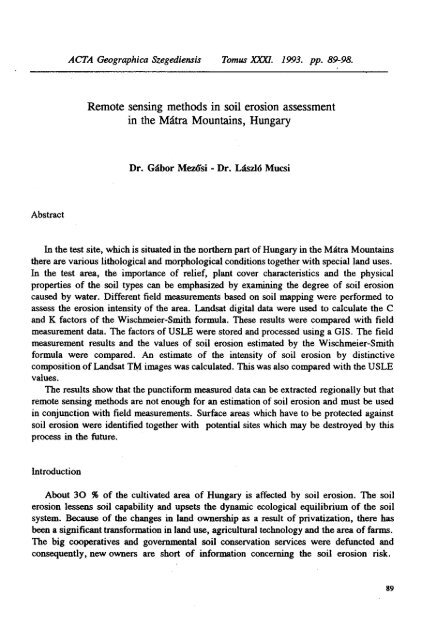


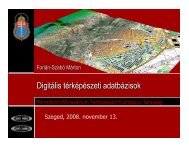

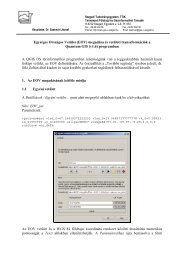
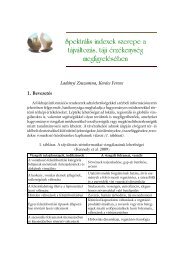
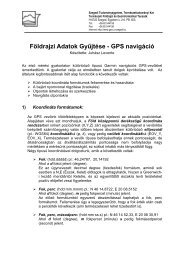
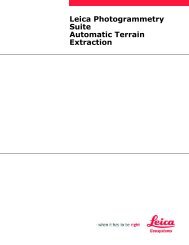
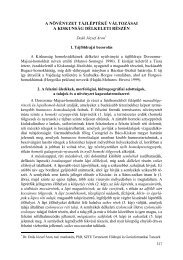
![TAVAK [Kompatibilitási mód]](https://img.yumpu.com/31087107/1/190x135/tavak-kompatibilitasi-mad.jpg?quality=85)
